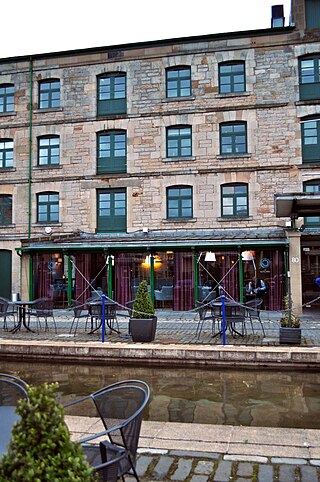
Bovril is the trademarked name of a thick and salty meat extract paste, similar to a yeast extract, developed in the 1870s by John Lawson Johnston. It is sold in a distinctive bulbous jar and as cubes and granules. Bovril is owned and distributed by Unilever UK. Its appearance is similar to the British Marmite and its Australian equivalent Vegemite; however, unlike these products, Bovril is not vegetarian.

A tray is a shallow platform designed for the carrying of items. It can be fashioned from numerous materials, including silver, brass, sheet iron, paperboard, wood, melamine, and molded pulp. Trays range in cost from inexpensive molded pulp trays which are disposable and inexpensive melamine trays used in cafeterias, to mid-priced wooden trays used in a home, to expensive silver trays used in luxury hotels. Some examples have raised galleries, handles, and short feet for support.

Waiting staff (BrE), waiters / waitresses, or servers (AmE) are those who work at a restaurant, a diner, or a bar and sometimes in private homes, attending to customers by supplying them with food and drink as requested. Waiting staff follow rules and guidelines determined by the manager. Waiting staff carry out many different tasks, such as taking orders, food-running, polishing dishes and silverware, helping bus tables, entertaining patrons, restocking working stations with needed supplies, and handing out the bill.

Three European Union schemes of geographical indications and traditional specialties, known as protected designation of origin (PDO), protected geographical indication (PGI), and traditional specialities guaranteed (TSG), promote and protect names of agricultural products and foodstuffs. Products registered under one of the three schemes may be marked with the logo for that scheme to help identify those products. The schemes are based on the legal framework provided by the EU Regulation No 1151/2012 of the European Parliament and of the Council of 21 November 2012 on quality schemes for agricultural products and foodstuffs. This regulation applies within the EU as well as in Northern Ireland. Protection of the registered products is gradually expanded internationally via bilateral agreements between the EU and non-EU countries. It ensures that only products genuinely originating in that region are allowed to be identified as such in commerce. The legislation first came into force in 1992. The purpose of the law is to protect the reputation of the regional foods, promote rural and agricultural activity, help producers obtain a premium price for their authentic products, and eliminate the unfair competition and misleading of consumers by non-genuine products, which may be of inferior quality or of different flavour. Critics argue that many of the names, sought for protection by the EU, have become commonplace in trade and should not be protected.

A blender is a kitchen and laboratory appliance used to mix, crush, purée or emulsify food and other substances. A stationary blender consists of a blender container with a rotating metal or plastic blade at the bottom, powered by an electric motor that is in the base. Some powerful models can also crush ice and other frozen foods. The newer immersion blender configuration has a motor on top connected by a shaft to a rotating blade at the bottom, which can be used with any container.
A cup holder is a device, such as a zarf, to hold a cup or other drinking vessel. It may be free standing to hold cups securely on a desk or other flat surface, or in a tree style to store sets of cups in kitchens. They may be built into automobiles or chairs, or fixed to the walls of airplanes, boats, buses and trains.

The List is a digital guide to arts and entertainment in the United Kingdom.

Clarence Birdseye was an American inventor, entrepreneur, and naturalist, considered the founder of the modern frozen food industry. He founded the frozen food company Birds Eye. Among his inventions during his career was the double belt freezer.

Catherine Mary Jamieson is a Scottish business director, currently a director at Kilmarnock Football Club and former politician. She served as the Deputy Leader of the Labour Party in Scotland from 2000 to 2008. She previously served in the Scottish Executive as Minister for Justice from 2003 to 2007 and Minister for Education and Young People from 2001 to 2003. Jamieson was Member of the Scottish Parliament (MSP) for Carrick, Cumnock and Doon Valley from 1999 to 2011 and was a Member of Parliament (MP) for Kilmarnock and Loudoun from 2010 to 2015.

A cable tie is a type of fastener for holding items together, primarily electrical cables and wires. Because of their low cost, ease of use, and binding strength, cable ties are ubiquitous, finding use in a wide range of other applications. Cable ties were first manufactured by Thomas & Betts under the brand name Ty-Rap.
The multinational technology corporation Apple Inc. has been a participant in various legal proceedings and claims since it began operation and, like its competitors and peers, engages in litigation in its normal course of business for a variety of reasons. In particular, Apple is known for and promotes itself as actively and aggressively enforcing its intellectual property interests. From the 1980s to the present, Apple has been plaintiff or defendant in civil actions in the United States and other countries. Some of these actions have determined significant case law for the information technology industry and many have captured the attention of the public and media. Apple's litigation generally involves intellectual property disputes, but the company has also been a party in lawsuits that include antitrust claims, consumer actions, commercial unfair trade practice suits, defamation claims, and corporate espionage, among other matters.
Silver service is a method of foodservice at the table, with the waiter transferring food from a serving dish to the guest's plate, always from the left. It is performed by a waiter by using service forks and spoons from the diner's left. In France, it appears to be now known as service à l'anglaise, although historically that meant something else, with the hostess serving out the soup at one end of the table, and later the host carving a joint of meat at the other end, and diners serving themselves with other dishes.

A lazy Susan is a turntable placed on a table or countertop to aid in distributing food. Lazy Susans may be made from a variety of materials but are usually glass, wood, or plastic. They are circular and placed in the centre of a table to share dishes easily among diners. Although they are common in Chinese restaurants, the lazy Susan is a Chinese-American invention. Owing to the nature of Chinese cuisine, especially dim sum, they are common at formal Chinese restaurants both in mainland China and abroad. In Chinese, they are known as 餐桌转盘 or "dinner-table turntables".

Chicken Licken is a South African fast-food fried chicken restaurant chain. The company had a 5% share of South Africa's fast food market in 2010, tying with McDonald's. According to a case study published by the Henny Penny Corporation in 2011, Chicken Licken is the "largest non-American-owned fried chicken franchise in the world".
Restaurants fall into several industry classifications, based upon menu style, preparation methods and pricing, as well as the means by which the food is served to the customer. This article mainly describes the situation in the US, while categorisation differs widely around the world.
Scams in intellectual property include scams in which inventors and other rights holders are lured to pay money for an apparently official registration of their intellectual property, or for professional development and promotion of their ideas, but do not receive the expected services.


A timeline of United States inventions (1890–1945) encompasses the ingenuity and innovative advancements of the United States within a historical context, dating from the Progressive Era to the end of World War II, which have been achieved by inventors who are either native-born or naturalized citizens of the United States. Copyright protection secures a person's right to his or her first-to-invent claim of the original invention in question, highlighted in Article I, Section 8, Clause 8 of the United States Constitution which gives the following enumerated power to the United States Congress:
To promote the Progress of Science and useful Arts, by securing for limited Times to Authors and Inventors the exclusive Right to their respective Writings and Discoveries.
'The Queen's Award for Enterprise: International Trade (Export) (2010)' was awarded on 21 April.

Know Labs, Inc is a US-based medical device company that creates non-invasive health monitoring systems for glucose in addition to sensor technology using radio-microwave spectroscopy to identify and measure molecules in vivo. Know Labs is a public company whose shares trade under the stock symbol KNW.

















